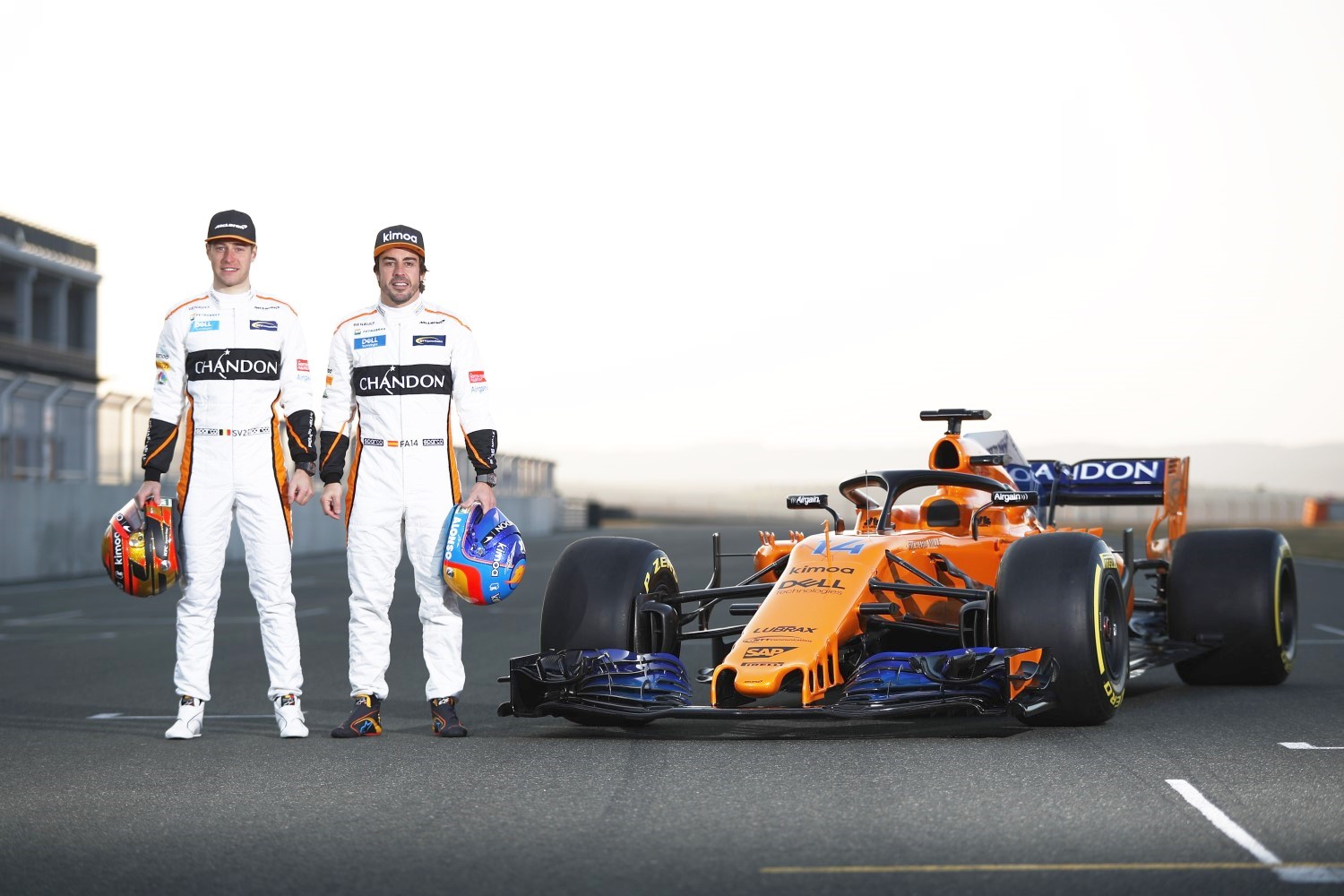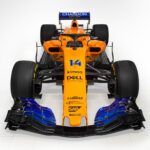McLaren Unveils Striking 2018 Challenger: The MCL33
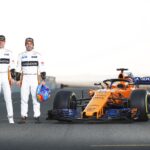 |
| Vandoorne and Alonso with the MCL33 |
McLaren today revealed its much-anticipated new Formula 1 car.
The striking MCL33 will contest the 2018 FIA Formula 1 World Championship, and marks the first time in McLaren’s 52-year history that it has run a car powered by Renault engines.
The car will race in a stunning new livery that draws its inspiration directly from the team’s iconic papaya orange and blue color scheme that McLaren first raced in Formula 1 50 years ago. The MCL33 will be driven by Spain’s Fernando Alonso, the F1 double world champion entering his fourth consecutive season with McLaren, and his team-mate Stoffel Vandoorne of Belgium, who is starting his second season in Formula 1.
The engineering philosophy of the MCL33 follows the roots established by its predecessor, with data accumulated from the 2017 season feeding a range of improvements. Much of the work on the MCL33 has been around optimizing the packaging of the new Renault engine, and the incorporation of the new halo device.
The MCL33 will conduct a dynamic filming day at a Spanish test track on Friday before beginning eight days of pre-season testing at the Circuit de Barcelona-Catalunya next Monday.
Fernando Alonso #14
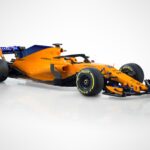 |
||
|
||
| A much simpler car than the Mercedes and Ferrari |
“My winter has felt somewhat shorter than usual, as I’ve already been in the cockpit for a 24-hour race, and several sports car tests! That said, I’m really looking forward to getting behind the wheel of a Formula 1 car for the first time in three months.
“Looking at our new car, I feel incredibly excited – but also apprehensive. I know just how important this car is to the team, and I just hope that it delivers in the way we all want it to.
“If we’re able to develop the key strengths of last year’s chassis and marry it to an improved Renault power unit, then I think we’ll be able to take a step forwards. The car certainly looks very neat and well thought-out, and I think the new color looks really great; really eye-catching.
“I just want to get behind the wheel now!"
Stoffel Vandoorne #2
“The arrival of a new car is always one of the most tense and exciting moments of the season. For everyone at McLaren, this is an important car; we all know exactly how much rests on it being successful, and we’re all extremely keen to see just how well it performs when we start testing it next week.
“From my perspective, I really hope we can start the season with a stable platform that we’re able to develop quickly and easily. It would be great to have a smooth few weeks of winter testing, and to go to Australia feeling confident about the year ahead.
“I’ve been training hard all winter and feel as ready as I can be to get back into the cockpit. I’m fit and focused, but I’m also relaxed, because I think we’ve had a very productive winter and have designed a very capable new car.
“I can’t wait to put it to the test."
Shaikh Mohammed bin Essa Al Khalifa, Executive Chairman and Executive Committee Principal, McLaren Group:
“The MCL33 represents a fresh chapter for McLaren – one that clearly embraces our evocative history while also serving to guide our future. We may have faced a tricky last few years, but this team has demonstrated time and time again that it emerges stronger from each and every challenge.
“And, for 2018, it’s not merely the color of the car that marks the change: there’s a determination and commitment that exists within everyone who works at McLaren, and we’re fighting stronger than ever to return to the front.
“I also want to acknowledge the loyal support of our long-standing partners including Chandon, NTT Communications, Hilton, Richard Mille, Norton Rose Fulbright, SAP and all our official partners and suppliers.
“We have strong leadership, hugely experienced and talented people, new partners, and motivated, exciting racers behind the wheel.
“We are ready to race."
Mansour Ojjeh, Executive Committee Member, McLaren Group:
[adinserter name="GOOGLE AD"]“It’s imperative that McLaren looks to re-establish itself on the track this year.
“Off-track, we have been working as strongly as ever: this year’s car is the result of a fantastic amount of teamwork and effort, of which we can be hugely proud. As ever, this formidable team keeps pushing itself forward, and I applaud everyone at McLaren for their relentless commitment to the mission.
“It’s fantastic to be able to return McLaren’s grand prix cars to the classic papaya orange livery they once sported in the 1960s. They look incredible, and really underline the fearless spirit with which we attack the new season.
“As a team, we have always been at our best when we are at our bravest, and I think this is another example of that indomitable spirit."
Zak Brown, Executive Director, McLaren Technology Group:
 |
| Top View |
“The McLaren team was created by a brave pioneer, and has had bravery at its core ever since. Whether it’s been with brave drivers, brave leaders or brave fortune, this team has always fought back.
“And we definitely view 2018 as the year when McLaren will move closer to the front, fighting teams and drivers as we improve our fortunes.
“We have an excellent team, a new engine partner in Renault and a host of fantastic new partnerships: Airgain, CNBC, Dell Technologies, Kimoa and Petrobras have all been welcomed to the McLaren family.
“Our return to a papaya orange livery for this year wasn’t simply an emotional decision; it demonstrates that we are listening to our fans, building deeper engagement with them and the Formula 1 community as a whole.
“We want McLaren to earn respect on and off the track, and this felt like a good starting point. We want to show everyone what makes this team special, whether that’s our fans or our partners – there’s room for more on our journey."
Eric Boullier, McLaren Racing Director:
“I think the whole team feels proud of this car.
“The design, engineering and aerodynamic departments have done an incredible job delivering a new car with a new power unit in an extremely short timeframe. We never took the easy route or looked to shortcut a process or a solution; and the result is a car that is neat and well-resolved.
“That said, we are under no illusions that it will be difficult to splinter the hegemony at the front; and that the midfield will be full of well-funded, experienced outfits with plenty to prove. We are humble about the challenge ahead, but feel we’ve prepared well, have a solid package that we can build upon and exploit as the season progresses, and have two excellent drivers who will make the difference in races.
“At McLaren, we are all racers – pure and simple. We’re going to come out pushing, and we’re going to be racing as hard as ever."
The technical lowdown
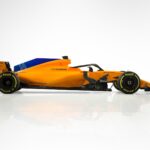 |
| Will McLaren be able to stay on same lap as the Mercedes at the finish this year |
Technically, the McLaren MCL33 is a logical development of last year’s car.
But it’s been developed and refined with the benefit of a year’s experience with the current regulations.
“With last year’s car, we had to commit to certain decisions about architecture based on what we knew at the time," says Tim Goss, McLaren’s Chief Technical Officer – chassis. “With a year of track learning behind us, we’ve used that understanding to adjust some architectural decisions. That means we’ve been able to revise all the sorts of things you bake into the chassis at the start of the year."
The theory of evolution
“We’re definitely continuing along the same trajectory," continues Goss. “For launch, the car will look evolutionary, and we will continue enhancing the MCL33 through testing and the race season.
In terms of development, the design team has focused on refining the package; making it neater, simpler and more elegant."
“That’s always been an area of focus for us," says Goss. “But, this year, we went beyond to get a neat and tidy packaging solution. And that just gives the aerodynamicists more scope to play with the bodywork."
Power to the people
Creating that neat packaging has brought its fair share of challenges. Beneath the bodywork lies a new power unit with a significantly different philosophy to its predecessor.
“That change has been a big deal," says Goss. “Even though the regulations state that the front and rear engine mounts need to be the same for every manufacturer, the layout of the engine, its architecture, is very different from before.
“There are two families of engine out there; the Mercedes and Honda concept, with the compressor at the front of the engine, turbine at the back, MGU-H sat in the vee; and the Ferrari and Renault approach, where the turbocharger is at the back of the engine, and the MGU-H sits forwards into the vee.
“Each of those approaches has its pros and cons, but I’m actually quite a big fan of the Renault approach. Making the switch had a big impact on the installation of the engine. The advantage of the Renault layout means that we can push the engine forwards, but then you have the compressor at the back of the engine, so you’ve got to get the outlet pipes forward without impacting the packaging.
“We had to redesign the back of the chassis, the gearbox bell-housing area, the rear suspension, and the cooling layout. That was two weeks of intense effort to get right. But it was something we were somewhat prepared for, because we knew it might happen, and it’s amazing what people can do in such a short space of time when the chips are down and you’ve got a really clear mission.
“So now we’ve got a really tidy packaging solution; the gearbox and rear suspension designers did an unbelievable job to redesign everything."
It’s a marker of the strength in depth of the department that it could incorporate such a fundamental change to the car so late into the design stage, and still deliver to plan.
“That’s because we’ve got a very tight-knit engineering group," Goss explains. “There’s a very clear level of communication between us, so we could make quick and bold decisions, then just get on with it."
Be brave, indeed.
These colors run deep
McLaren’s distinctive orange livery was successful across Formula 1, the Indy 500 and the CanAm series. For 2018, the MCL33 spectacularly revives the original colors of McLaren – papaya orange and dark blue – in a refreshing new way.
Inspired by the numerous entreaties of our fans, the return to papaya was also driven by McLaren looking to its past to shape its future. The unique papaya livery is an overt statement of the team’s next chapter, and symbolic of McLaren at its simplest, purest form: that of racers.
It reflects the essential qualities that have remained constants for McLaren throughout its history and are intrinsic to its future. In particular, it evokes the bravery of the team; played out through the #BeBrave campaign that has previewed the launch and will remain a feature of the 2018 season.
McLaren first used papaya in 1968, another convention-busting decision of founder Bruce McLaren. At a time when many nations raced under traditional national colors, such as British Racing Green, French Racing Blue and Italian Rosso Corsa, Bruce chose papaya to make his eponymous team stand out on the racetrack.
The MCL33’s eye-catching primary color, Papaya Spark, and secondary colors, Burton Blue and Cerulean Blue, were each developed in collaboration with McLaren partner AkzoNobel. The innovative coating systems supplied by the company have enabled the team to significantly reduce the total weight of paint and decrease paint processing time by more than 50%.
